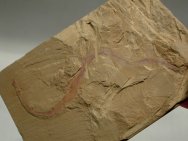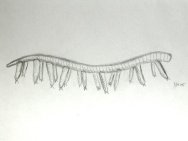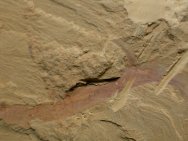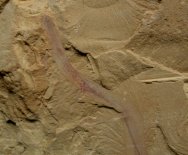|
 Description:
The discovery of the Chengjiang Biota by Hou Xian-guang in 1984
resulted in a clear window on what is known as the Cambrian Explosion.
The diversity of soft-tissue fossils is astonishing: algae, medusiforms,
sponges, priapulids, annelid-like worms, echinoderms, arthropods
(including trilobites), hemichordates, chordates, and the first
agnathan fish make up just a small fraction of the total. Numerous
problematic forms are known as well, some of which may have represented
failed attempts at diversity that did not persist to the present
day. Description:
The discovery of the Chengjiang Biota by Hou Xian-guang in 1984
resulted in a clear window on what is known as the Cambrian Explosion.
The diversity of soft-tissue fossils is astonishing: algae, medusiforms,
sponges, priapulids, annelid-like worms, echinoderms, arthropods
(including trilobites), hemichordates, chordates, and the first
agnathan fish make up just a small fraction of the total. Numerous
problematic forms are known as well, some of which may have represented
failed attempts at diversity that did not persist to the present
day.
The
Lobopodians are small marine and terrestrial animals termed colloquially
“velvet  worms”
or “worms with legs”. While all Recent forms are terrestrial,
most fossil Lobopodians are marine, and are known primarily from
the Cambrian. Six named genera, each with a single species, are
known from the Chengjiang Biota, making it the richest source of
fossils of the type on Earth. This is one of the most unusual, and
quite rare; it was originally known from only four incomplete specimens,
and was given the generic name Paucipodia (few feet) because it
was thought to have 3 fewer pairs of legs than other members. A
scant few recent examples show a complement of nine leg pairs. Each
leg bears curved claws which are thought to have served the creature
as an adaptation to crawling on other organisms. Indeed, some have
been found in close association with Eldonia. It is most closely
related to Aysheaia from the younger Burgess Shale. This one is
at the upper size limit of known specimens, and has several well-preserved
legs; the distal portion shows a few “buds’ here the
rest of the appendages were located. worms”
or “worms with legs”. While all Recent forms are terrestrial,
most fossil Lobopodians are marine, and are known primarily from
the Cambrian. Six named genera, each with a single species, are
known from the Chengjiang Biota, making it the richest source of
fossils of the type on Earth. This is one of the most unusual, and
quite rare; it was originally known from only four incomplete specimens,
and was given the generic name Paucipodia (few feet) because it
was thought to have 3 fewer pairs of legs than other members. A
scant few recent examples show a complement of nine leg pairs. Each
leg bears curved claws which are thought to have served the creature
as an adaptation to crawling on other organisms. Indeed, some have
been found in close association with Eldonia. It is most closely
related to Aysheaia from the younger Burgess Shale. This one is
at the upper size limit of known specimens, and has several well-preserved
legs; the distal portion shows a few “buds’ here the
rest of the appendages were located.
|







